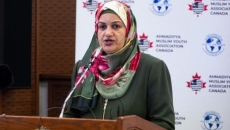Canada is embarking on an effort to test the boundaries of its shared border with the United States, launching a pilot project that would allow northbound land travellers to clear customs while still on U.S. soil.
The federal government is soliciting public comment on the planned project which would establish a preclearance zone inside a Customs and Border Protection facility in Cannon Corners, N.Y., south of Montreal.
"Here's the announcement we've been waiting for," the binational Future Borders Coalition lobby group enthused last week in an email to its membership.
The notice says the Canada Border Services Agency hopes to launch the two-year project later this year to determine whether similar setups could replace smaller, aging facilities on the Canadian side of the border.
The project carries a price tag of $7.4 million, money that was allocated in the 2021 federal budget.
"We know that preclearance works extremely well for air travel. It makes a lot of sense to expand it to other modes, taking the lessons from air and building on them," said Laura Dawson, the coalition's executive director.
Dawson said the coalition is busily preparing its own detailed response to the government's brief on the project, which was published last month in the Canada Gazette.
"There is a consensus among industry and government that the next step should be expansion to other sites such as the Pacific Northwest, to other modes such as rail and maritime, and northbound air preclearance for passengers departing to Canada from popular snowbird sites such as Arizona or Florida."
The project would establish a "designated preclearance area and perimeter" at the Cannon Corners location, just 25 kilometres west of the much busier entry point linking St-Bernard-de-Lacolle, Que., and Champlain, N.Y.
It would also mark Canada's first foray into pre-clearing inbound travellers, something the U.S. has been doing with southbound travellers at airports north of the border since 1952.
"Establishing Canadian preclearance operations in the United States would support government and industry goals to facilitate the flow of legitimate travellers and goods across the border," the Canada Gazette notice says.
"It would also increase the safety and security of Canadians and the Canadian economy by pushing the border out to prevent inadmissible people and goods from entering Canada."
The agency operates some 80 smaller, more remote land crossing facilities along the Canada-U. S. border, many of them in "various states of disrepair," it notes.
That's because larger, busier entry points, such as the Ambassador Bridge between Detroit and Windsor, Ont., or the Peace Arch in Surrey, B.C., take precedence when it comes to upgrades.
The initiative "is a smart use of scarce resources and a great example of how Canadian and U.S. officials can work together for the benefit of travellers from both countries," Dawson said.
"New technologies for passenger and cargo screening will help achieve the dual goals of security and efficiency."






